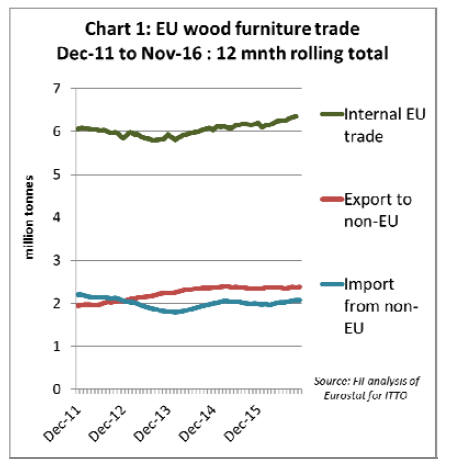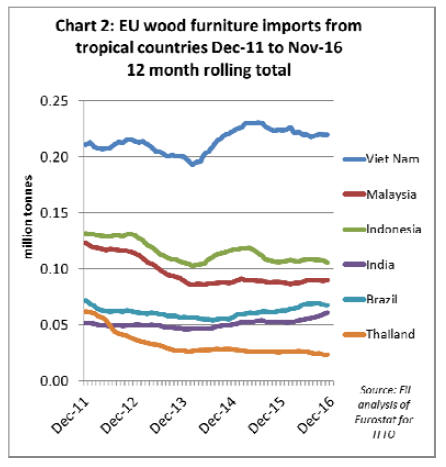|
Report from
Europe
Indonesia makes big impact at IMM Furniture Fair
Like the Domotex show held in Hanover earlier in the
month, the IMM Furniture Fair in Cologne between 16
and 22 January highlighted the challenges facing tropical
suppliers looking to increase their share of the European
market, as pressure continues to mount from domestic
manufacturers and non-wood materials.
Demand for wooden exterior furniture, traditionally an
important niche market for tropical wood products, is
coming under pressure from other modern weatherresistant
materials.
However, the Fair also emphasised that wood, alongside
other natural materials and organic finishes, is very
fashionable for interior furniture, that there is strong
interest in furniture with a strong back story, and that
small, well-designed products have an important role in
the European furniture sector. All these trends offer new
avenues to market for suppliers of tropical wooden
furniture.
As if to emphasise these opportunities, the headline of the
leading article on the IMM show by Decoist, a leading online
magazine focused on architecture and modern design
was ※Wood is beyond good 每 it*s sensational!§.
Decoist observes that ※one of the big furniture design
trends of 2017 is undoubtedly the way in which top
manufacturers and designers have so whole heartedly
embraced wood. In a world where organic finishes and
natural materials are making a rapid comeback, wood is
definitely the absolute king of 2017 and this trend is likely
to continue to last beyond the year as well!§
Decoist*s comment that ※Indonesia made a big impact at
this year*s show with their unique creations§ is
particularly encouraging for the tropical wood sector and
an early sign of the potential of Indonesia*s market
development strategy in Europe.
Indonesia had a significant presence at the show having
booked just under 600 square metres for a national
pavilion displaying products from a wide range of
Indonesian companies, a timely investment in marketing
for a national furniture industry that is the first, and only
capable of delivering 100% FLEGT-licensed product.
Indonesia did well to target IMM Cologne which is now
one of world*s leading furniture shows following a
marketing drive to internationalise the event. The show
achieved a record number of visitors this year, exceeding
150,000 for the first time.
Of the 104,000 trade visitors, around 56,000 came from
Germany and 48,000 from abroad (an increase of 4%).
There were particularly large increases in visitor numbers
from Spain, Russia, Italy, the UK, Netherlands, Poland,
China, South Korea, India and the United Arab Emirates.
The show boasted around 1,200 exhibitors from 50
countries displaying more than 100,000 pieces of furniture
and furnishing items, a third of which were shown to the
international market for the first time in Cologne.
Non-wood materials taking greater share in exteriors
market
While wood is in the ascendance in the interiors sector, the
IMM show highlighted that alternative materials are
making more ground in the exteriors sector. Exterior
furniture continues to become more and more flexible and
decorative and adapts to growing demand for pieces that
can be used both inside and outside.
This demand is driven both by new materials and lifestyle
changes in which more people spend time on balconies,
decks, patios and similar spaces which combine features of
gardens and rooms.
Solid tropical wood garden furniture is increasingly
substituted by outdoor sofas and chairs comprising
modern, weather-resistant materials, with water resistant
cushions and frames created using steel or plastics woven
using traditional wicker techniques.
Teak is still popular, but mainly to accent and soften
furniture made primarily in other materials.
A star attraction of the show was the Caribe collection of
outdoor furniture designed for Ames by Sebastian
Herkner, a leading designer who was Guest of Honour at
the IMM Cologne show in 2016, in collaboration with
Colombian craftsmen. The pieces were made of woven
plastic string and steel using the "Momposino" weave
which is taught in school as a craft in the Santa Marta
region of Colombia.
While not made of wood, the message conveyed about the
Caribe collection in the IMM show publicity is relevant
and should give encouragement to manufacturers of
tropical wood furniture.
The IMM organisers observe that ※the Caribe series stands
for a trend in the interiors industry which is exemplary of
the growing need for meaningfulness among
manufacturers and consumers. And contrary to some
expectations, this trend is evidently being carried by the
market.
It is not always the case that one succeeds in combining
sustainable production with an aesthetic concept in a pilot
project while at the same time also accommodating the
increasing interest of people for authentic products.
However the number of products that tell their own special
story is constantly growing.§
Another trend at the IMM show that could be exploited by
the tropical timber sector is to extend the use of solid
wood into the climatically difficult environment of the
bathroom. Together with the bathroom furniture
manufacturer, Keuco, the company Team 7 from Austria
was displaying the Lignatur edition at IMM Cologne
which utilises natural wood to provide a high quality and
unique finish to bathrooms.
Again, the material used in this instance was not tropical
timber, the traditional European favourites of walnut and
oak being preferred. However, use of tropical wood would
offer manufacturers both technical and aesthetic
advantages in high-end bathroom furniture.
Furniture trade in Europe growing slowly
The trade background to the IMM fair is shown in Chart 1
which indicates that internal EU trade in wood furniture
has been rising slowly since December 2013.
This is due partly to improving consumption of wood
furniture products manufactured in the EU, and to the
increasing role of manufacturing facilities in lower cost
Eastern European countries such as Poland and Lithuania
to supply wood furniture to other parts of the EU.

The EU continues to maintain a small trade deficit in
wood furniture with the rest of the world. Total EU
exports to non-EU countries remained level at around 2.4
million tonnes in both 2015 and 2016, while imports were
also stable at around 2 million tonnes.
EU imports of wood furniture from China, which is by far
the largest external supplier accounting for 50% to 55% of
the total, were sliding in 2015 and the first half of 2016,
but recovered slightly towards the end of last year.

The performance of tropical countries in supply of wood
furniture to European markets has been mixed in recent
years (Chart 2). EU imports from Vietnam increased
sharply between April 2014 and April 2015, taking share
from China at that time.
However, EU imports from Vietnam were sliding slowly
between mid-2015 and the end of 2016.
EU imports of wood furniture from Indonesia surged
briefly and temporarily in 2015, but fell back again in
2016.
It will be interesting to see whether Indonesia*s delivery of
FLEGT licensed furniture and support for marketing in
Europe will now be translated into an increase in sales.
Meanwhile EU imports of wood furniture from Malaysia
and Thailand have been broadly flat over the last 3 years
after losing ground in 2011 and 2012.
In contrast EU imports from Brazil and India have been
making ground in the last two years, although both are still
relatively minor suppliers of wood furniture to the EU.
EU importers stock up on FLEGT licensed Indonesian
plywood
The Global Timber Forum has published an interview with
the CEOs of two European importing companies,
Alexander de Groot of Fepco and Koen de Witte of
Altripan, that were among the first to receive FLEGT
licensed wood from Indonesia.
The interview highlights both the market opportunities and
remaining challenges of FLEGT licensing from the
perspective of two of Europe*s largest plywood importing
companies.
According to Alexander de Groot, FLEGT licensing offers
a significant market opportunity for Indonesian plywood
in Europe as due diligence is no longer required and
buyers can be absolutely certain that all Indonesian wood
comes from legal sources.
Koen de Witte said that a large group of customers in
Europe have been afraid of buying tropical wood because
of possible EUTR problems and related negative publicity
but that FLEGT licensing means importers can now start
promoting tropical wood to these companies again.
Koen de Witte noted that products from Indonesia are
rather expensive compared to competing materials from
China or Malaysia and that logistics can be a challenge,
however FLEGT licensing offers an opportunity to
promote Indonesian plywood as a legal and high quality,
sustainable product. He said that Indonesia will also have
an increasing advantage over time as EU Competent
Authorities are getting stricter and there are more checks
on operators.
Koen de Witte said that there has yet to be any perceptible
increase in demand from their own customers for FLEGT
licensed timber, but ※arrivals of wood from Indonesia have
increased over the last few weeks as importers and traders
are stocking up on FLEGT licensed material§.
He also emphasised that it is early days and companies
like Fepco and Altripan will now push to increase sales
with active promotion and by making the more product
available in the market.
Koen de Witte reckoned that Indonesian wood products
are competitive in Europe and their market share will
increase - although this will be partly dependent on
developments in competing products which, for
Indonesian plywood, are mainly from Russia and China.
He suggested that ※the great variety of products from
China 每 in very different qualities and not always correctly
declared 每 is making life difficult. But there are initiatives
now to increase transparency and show customers how the
plywood is made and what the differences are. This will
improve Indonesia*s position§.
Alexander de Groot emphasized that European
governments also have a responsibility now to help
promote FLEGT licensed wood. He suggested that
FLEGT should, for example, immediately be incorporated
in public procurement rules and given the same status as
FSC or PEFC.
He noted that ※one of our customers just had a case in
Luxembourg, where authorities would not accept FLEGT
licensed wood on a bid for a public building project 每 they
only wanted FSC. This situation cannot continue - if
European governments are not behind FLEGT this will
sabotage the process§.
Both CEOs confirmed that of their own customers, the
larger distribution groups and merchants in Europe are
already familiar with the FLEGT process, but as large
corporations their decision-making processes are fairly
slow so it might take some time before they start
purchasing more FLEGT licensed wood. Smaller
merchants are generally less aware of FLEGT.
At present importers are still more inclined to prefer FSC
and PEFC, particularly in the UK and the Netherlands, but
here merchants are quickly becoming aware of the
importance of FLEGT licenses. France, Belgium and
Germany are more difficult as companies there use less
certified wood in general and interest in FLEGT is
perceptibly lower.
While recognizing that their Indonesian suppliers had to
work extremely hard to achieve FLEGT licensing, both
CEOs said that from the perspective of European
importers the process has been very simple. The importers
only had to register to obtain a FLEGT license number and
the rest was pretty much what they always had to do when
importing wood.
For them it basically comes down to uploading some
information on a website and is much simpler than having
to conform to EUTR due diligence requirements.
|